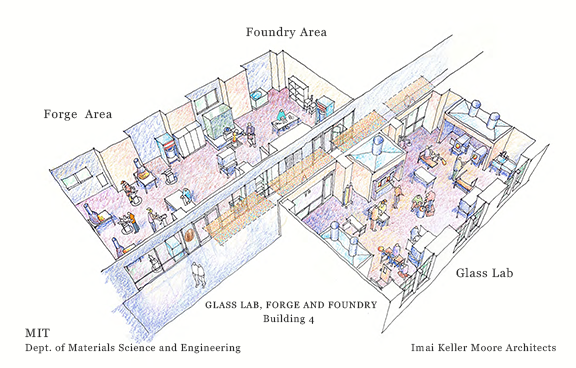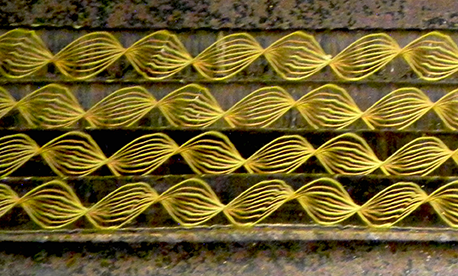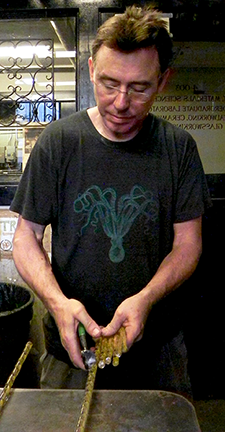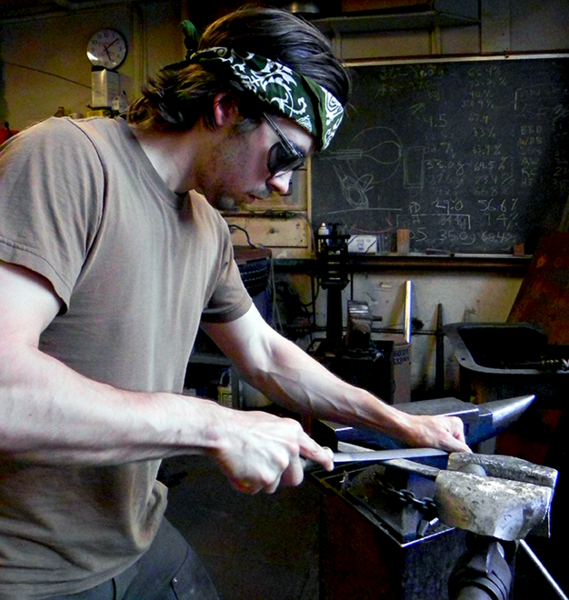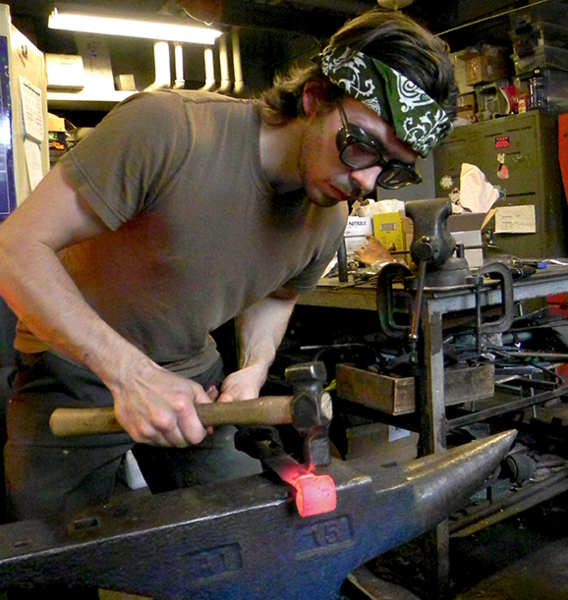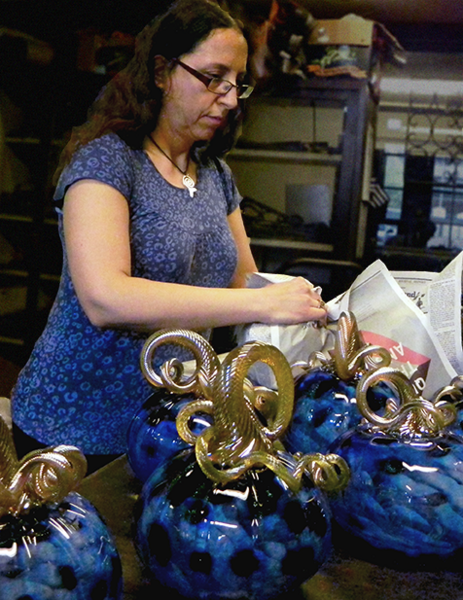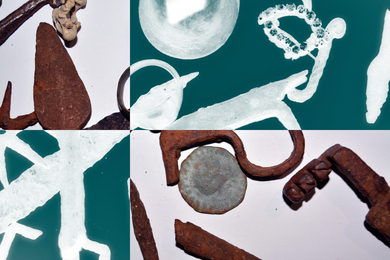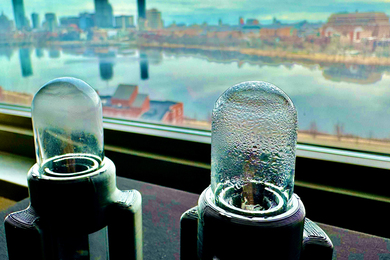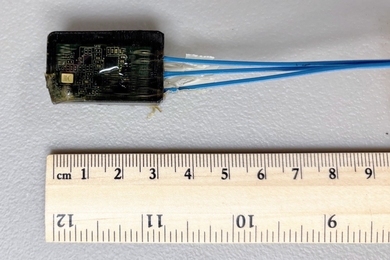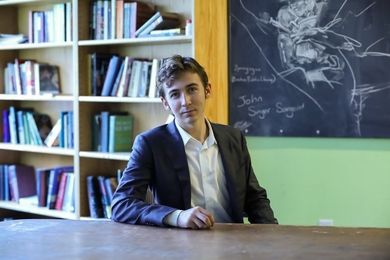MIT's Glass Lab and the Forge and Foundry spaces will close after graduation on June 6 for major renovations. These renovations will serve more students and provide better space for the popular programs in Building 4, with floor-to-ceiling glass walls along interior corridors.
"Visitors walking along the Infinite Corridor love to stop and look through the windows to see people making things. We'll now also have a display case in the hall where finished products from both programs can be displayed," says Peter Houk, director of the Glass Lab.
The basement space will be similar to the Laboratory for Advanced Materials, located at the junction of Buildings 4 and 8, which opened in 2010. The Glass Lab will face onto a new courtyard between Building 4 and the new MIT.nano building, which also begins construction this summer with the demolition of the old Building 12.
“At the same time we are erecting a new building dedicated to future processing technologies, nanofabrication and characterization, right next to the main building. We're renovating these spaces for what I would call manufacturing science and classical materials processing technologies,” says Christopher A. Schuh, head of the Department of Materials Science and Engineering (DMSE). “Our values are about getting students in the labs, getting their hands dirty. They’re going to get to work with hot, molten metal, hot flowable glass, and this is reinforcement for what we do in the classroom.”
Serving more students
The Forge, which currently shares space inside the Glass Lab, will move across the hall and will be joined by the Foundry, which also is moving from Building 8.
Freeing up space in the Glass Lab will double the number of students it serves each year (from 48 to 96). The lab currently accommodates 16 beginners during each fall semester, Independent Activities Period (IAP), and spring semester. About 36 intermediate and advanced students also use the lab.
"What's really driving the Glass Lab part of this renovation is our beginning glass blowing program," Houk explains. "The class is open to everybody at MIT, but the people who show up at the lottery are by and large undergrads. We have something like 200 to 250 show up for a lottery for 16 available spots."
The Glass Lab will grow from two to four workstations. Each workstation has a bench that the glass blower sits at, while shaping the glass and a hole that functions as a way to reheat the glass. One central glass-melting furnace will serve the entire space.
The plan is to have renovations completed by December 2014 and classes to resume during IAP in January 2015.
The MIT Glass Lab is administratively co-sponsored by the Materials Processing Center and the DMSE. Michael Cima, the David H. Koch Professor of Engineering, is faculty director for the Glass Lab.
MIT Facilities, Imai Keller Moore Architects, and Turner Construction produced the design. The Provost's office helped identify spaces for the facilities, so they can be close to one another. "They really do belong together. It's all one center for materials processing and manufacturing science," Schuh says.
The glass and metal programs are collaborating with the architect on lighting fixtures for the hallway. Each fixture would consist of many glass marbles inserted into holes in perforated metal sheets, with light filtering down into the corridor from above. "For the prototype, I've got about 12,000 marbles and a sheet of perforated steel," Houk says. Houk and DMSE Lecturer Michael J. Tarkanian will test the fixtures before committing to them.
Demand is high
About 100 students take classes during IAP in the Forge and Foundry. "In blacksmithing in January, I take 54 students. It filled up in a matter of hours and there have been hundreds in the past that have tried to get in, so the demand is high for metal working as well as glass," Tarkanian says.
About 60 to 70 students from 3.014, a sophomore-level materials science and engineering lab, make use of the facilities, and another 36 from 3.094 (Materials in Human Experience) do casting and forging. Another 50 or so who have training use the facilities informally during Open Forge nights throughout the year. Students in the Forge and Foundry program make commemorative medallions that are given to every DMSE graduate.
"For materials scientists, it gives them real, tangible experience with metals. So they learn about theory in class, but then they get to see the theory in action when they are forging something or casting something or making their own alloys. That hands-on experience, I think, is valuable," Tarkanian says. "There aren't that many people that perform glass blowing in the world anymore. There aren't that many people who are blacksmithing in a traditional way. As engineers, it's important to understand the history and the methods previously used, because they can apply to modern problems, and you learn a lot about engineering topics by studying those processing techniques."
For 3.094, the 36 students are broken into smaller groups of 12 students each on Tuesday, Wednesday, and Thursday nights. "That can get really cramped, especially in the foundry, where you have 12 students working on 12 different castings. Materials are everywhere. They need a lot of space, and in the current configuration, it can get pretty crazy," Tarkanian explains. "For each of us to have our own space, regardless of the square footage, is going to change the way we operate for the better."
Multiple improvements
Combining the forge and foundry will lead to bigger projects, Tarkanian says. "It'll be easier for us to supervise students, since everyone will be working in one space rather than two completely different rooms. I think it'll be safer," he says.
The increased visibility with glass walls, similar to those upstairs on the Infinite Corridor, will also raise the profile of the Forge and Foundry. "The lab space will enable us to serve more students and the new lab space will cause us to need to serve more students," Tarkanian says.
The move will start with existing forges, foundry furnaces, and welding equipment, and then start adding new pieces. "On the forge side, I want to add a hydraulic press and a gas forge, which will allow us to have capabilities that we don't have now. On the foundry side, we're thinking of getting some vacuum furnaces and some higher tech foundry equipment that will allow us to be a state-of-the-art foundry for research or art or personal projects. Those pieces of equipment will also expand our capabilities," Tarkanian says. "The arrangement of the space really is what allows us to do a lot more things."
One recent project in the Glass Lab is hot 3-D printing. A team — comprised of mechanical engineering graduate student Michael Stern, Media Lab research assistant Markus Kayser, and media arts and sciences graduate student John Klein — is working with a hot glass 3-D printer in the lab. "What's interesting to me about this project is that the team members all come from different disciplines, bringing together mechanical engineering, art, and architecture. They're all putting different things into the project, as well as getting different things out," Houk says.
"In this case, we're actually simulating a hot glass furnace, dripping glass at 2,000 degrees or so," Houk explains. "A small kiln filled with molten glass moves along X, Y and Z axes laying down shapes of molten glass. Only a glass blower would say, 'Hey, let's take a furnace and just print straight out of the furnace.' That's an insane thing to do in a way, but we've gotten some interesting results, and I believe that it's entirely possible to do. I think they're going to figure it out."
Schuh also hopes the new facilities will spur renewed interest from and connections with industry.
